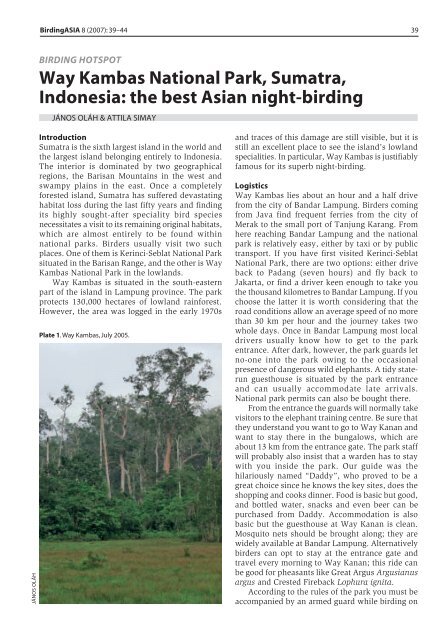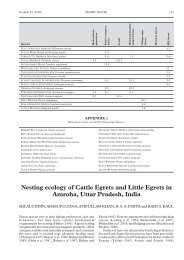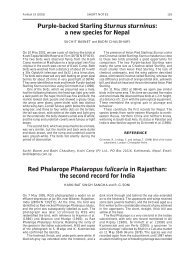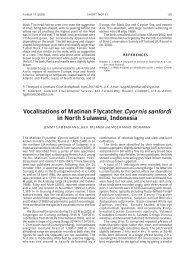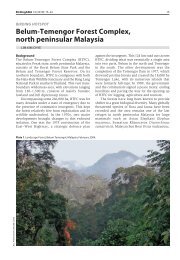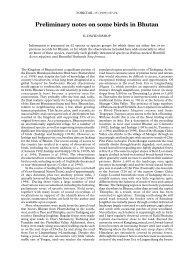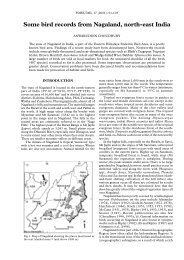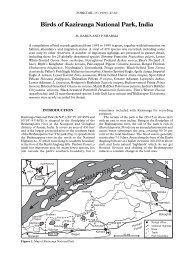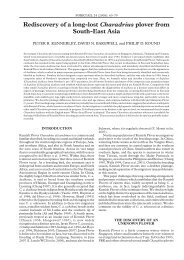Way Kambas National Park, Sumatra, Indonesia ... - Oriental Bird Club
Way Kambas National Park, Sumatra, Indonesia ... - Oriental Bird Club
Way Kambas National Park, Sumatra, Indonesia ... - Oriental Bird Club
Create successful ePaper yourself
Turn your PDF publications into a flip-book with our unique Google optimized e-Paper software.
JÁNOS OLÁH<br />
<strong>Bird</strong>ingASIA 8 (2007): 39–44 39<br />
BIRDING HOTSPOT<br />
<strong>Way</strong> <strong>Kambas</strong> <strong>National</strong> <strong>Park</strong>, <strong>Sumatra</strong>,<br />
<strong>Indonesia</strong>: the best Asian night-birding<br />
JÁNOS OLÁH & ATTILA SIMAY<br />
Introduction<br />
<strong>Sumatra</strong> is the sixth largest island in the world and<br />
the largest island belonging entirely to <strong>Indonesia</strong>.<br />
The interior is dominated by two geographical<br />
regions, the Barisan Mountains in the west and<br />
swampy plains in the east. Once a completely<br />
forested island, <strong>Sumatra</strong> has suffered devastating<br />
habitat loss during the last fifty years and finding<br />
its highly sought-after speciality bird species<br />
necessitates a visit to its remaining original habitats,<br />
which are almost entirely to be found within<br />
national parks. <strong>Bird</strong>ers usually visit two such<br />
places. One of them is Kerinci-Seblat <strong>National</strong> <strong>Park</strong><br />
situated in the Barisan Range, and the other is <strong>Way</strong><br />
<strong>Kambas</strong> <strong>National</strong> <strong>Park</strong> in the lowlands.<br />
<strong>Way</strong> <strong>Kambas</strong> is situated in the south-eastern<br />
part of the island in Lampung province. The park<br />
protects 130,000 hectares of lowland rainforest.<br />
However, the area was logged in the early 1970s<br />
Plate 1. <strong>Way</strong> <strong>Kambas</strong>, July 2005.<br />
and traces of this damage are still visible, but it is<br />
still an excellent place to see the island’s lowland<br />
specialities. In particular, <strong>Way</strong> <strong>Kambas</strong> is justifiably<br />
famous for its superb night-birding.<br />
Logistics<br />
<strong>Way</strong> <strong>Kambas</strong> lies about an hour and a half drive<br />
from the city of Bandar Lampung. <strong>Bird</strong>ers coming<br />
from Java find frequent ferries from the city of<br />
Merak to the small port of Tanjung Karang. From<br />
here reaching Bandar Lampung and the national<br />
park is relatively easy, either by taxi or by public<br />
transport. If you have first visited Kerinci-Seblat<br />
<strong>National</strong> <strong>Park</strong>, there are two options: either drive<br />
back to Padang (seven hours) and fly back to<br />
Jakarta, or find a driver keen enough to take you<br />
the thousand kilometres to Bandar Lampung. If you<br />
choose the latter it is worth considering that the<br />
road conditions allow an average speed of no more<br />
than 30 km per hour and the journey takes two<br />
whole days. Once in Bandar Lampung most local<br />
drivers usually know how to get to the park<br />
entrance. After dark, however, the park guards let<br />
no-one into the park owing to the occasional<br />
presence of dangerous wild elephants. A tidy staterun<br />
guesthouse is situated by the park entrance<br />
and can usually accommodate late arrivals.<br />
<strong>National</strong> park permits can also be bought there.<br />
From the entrance the guards will normally take<br />
visitors to the elephant training centre. Be sure that<br />
they understand you want to go to <strong>Way</strong> Kanan and<br />
want to stay there in the bungalows, which are<br />
about 13 km from the entrance gate. The park staff<br />
will probably also insist that a warden has to stay<br />
with you inside the park. Our guide was the<br />
hilariously named “Daddy”, who proved to be a<br />
great choice since he knows the key sites, does the<br />
shopping and cooks dinner. Food is basic but good,<br />
and bottled water, snacks and even beer can be<br />
purchased from Daddy. Accommodation is also<br />
basic but the guesthouse at <strong>Way</strong> Kanan is clean.<br />
Mosquito nets should be brought along; they are<br />
widely available at Bandar Lampung. Alternatively<br />
birders can opt to stay at the entrance gate and<br />
travel every morning to <strong>Way</strong> Kanan; this ride can<br />
be good for pheasants like Great Argus Argusianus<br />
argus and Crested Fireback Lophura ignita.<br />
According to the rules of the park you must be<br />
accompanied by an armed guard while birding on
JÁNOS OLÁH<br />
ROB HUTCHINSON/www.birdtourasia.com<br />
JÁNOS OLÁH<br />
40 <strong>Way</strong> <strong>Kambas</strong> <strong>National</strong> <strong>Park</strong>, <strong>Sumatra</strong>, <strong>Indonesia</strong>: the best Asian night-birding<br />
Plate 2. White-winged Duck Cairina scutulata, <strong>Way</strong> <strong>Kambas</strong>, July 2005.<br />
Plate 3. Storm’s Stork Ciconia stormi, <strong>Way</strong> <strong>Kambas</strong>, November 2006.<br />
Plate 4. Lesser Adjutant Leptoptilos javanicus, <strong>Way</strong> <strong>Kambas</strong>, July 2005.
<strong>Bird</strong>ingASIA 8 (2007) 41<br />
the trails (owing to the dangers of tiger and<br />
elephant); however, this is negotiable.<br />
The best time to visit <strong>Sumatra</strong> and <strong>Way</strong> <strong>Kambas</strong><br />
is during the northern summer. From July to<br />
September the weather is very hot and dry with an<br />
occasional heavy shower. This dry season is also<br />
the key to seeing some of the swamp specialities.<br />
<strong>Bird</strong>ing<br />
<strong>Way</strong> <strong>Kambas</strong> has a lot to offer for birdwatchers.<br />
Over 320 species of birds have been recorded in<br />
the park with several members of prized families<br />
like pheasants, broadbills, pittas, hornbills and<br />
frogmouths present. The main vegetation type is<br />
lowland dipterocarp rainforest, which is almost<br />
entirely secondary. Much swamp-forest, especially<br />
nibung swamps, are still to be found in more or<br />
less their original condition. These areas are<br />
probably the best place in the world to see Whitewinged<br />
Duck Cairina scutulata. In the dry season,<br />
when the water level is low, you have a good<br />
chance of finding these shy and wary birds. The<br />
most reliable areas have been in the Rawa Gajah<br />
(elephant swamp) swamps upriver from <strong>Way</strong><br />
Kanan. Other swamp-forest specialities also present<br />
here include Storm’s Stork Ciconia stormi and<br />
Lesser Adjutant Leptoptilos javanicus.<br />
Grassy swamps, where you can scan for raptors<br />
and pigeons, frequently interrupt the wooded areas.<br />
The clearing around <strong>Way</strong> Kanan is particularly good<br />
for these birds and the best forest birding is usually<br />
along the main jeep track and the loop trail just<br />
around the guesthouse. Many species of kingfisher,<br />
broadbill, barbet, trogon, cuckoo and babbler can<br />
be found along the trails. The early mornings are<br />
best for birding as between 10h00 and 15h00 the<br />
bird activity is very low and the heat almost<br />
intolerable. When walking in the grasslands a hat<br />
is essential! Also be prepared for a lot of leeches<br />
on the trails. If you stop for any bird the forest<br />
floor literally starts to move towards you. Leech<br />
socks are very useful, and without them you might<br />
finish the day picking dozens of leeches off your<br />
body. Double-check your feet when you’re on any<br />
elephant trail because the leeches are proportionate<br />
to the size of their target animals! The only almost<br />
completely leech-free trail is the main jeep-track.<br />
For most birders, however, <strong>Way</strong> <strong>Kambas</strong> means<br />
the ultimate night-birding heaven in Asia! Not only<br />
the great variety of the otherwise scarce and hardto-come-by<br />
species is what makes this national park<br />
world-famous but also the relative ease in finding<br />
them. <strong>Way</strong> <strong>Kambas</strong> is by far the most reliable site<br />
in the world for Large Frogmouth Batrachostomus<br />
auritus and the near-endemic Bonaparte’s Nightjar<br />
Caprimulgus concretus. Other interesting nightbirds<br />
include Gould’s B. stellatus and Sunda Frogmouths<br />
B. cornutus, <strong>Oriental</strong> Bay Owl Phodilus badius,<br />
Reddish Scops Owl Otus rufescens and Malaysian<br />
Eared Nightjar Eurostopodus temminckii. All these<br />
targets can be found along the main jeep-track.<br />
Dusk is usually better for the nightjars and scops<br />
owls, while later in the night, especially around<br />
22h00 and 04h30, is better for the frogmouths and<br />
<strong>Oriental</strong> Bay Owl.<br />
If your time in <strong>Way</strong> <strong>Kambas</strong> <strong>National</strong> <strong>Park</strong> is<br />
limited we would suggest birding at the <strong>Way</strong> Kanan<br />
substation and concentrating on the main jeep<br />
track, the loop trail and the Rawa Gajah swamps.<br />
<strong>Bird</strong>watching spots within the park<br />
Main jeep track: This is a 13-km dirt road from the<br />
entrance gate to the <strong>Way</strong> Kanan substation. It<br />
probably gives you the most productive birding<br />
especially in the early mornings. This is also the<br />
best area for night-birding and the last four<br />
kilometres are particularly good. Best birds: Crested<br />
Fireback, Great Argus, Crested Partridge Rollulus<br />
rouloul, Raffles’s Phaenicophaeus cholorophaeus,<br />
Red-billed P. javanicus and Black-bellied Malkohas<br />
P. diardi, <strong>Oriental</strong> Bay Owl, Reddish Scops Owl,<br />
Large Frogmouth, Gould’s Frogmouth, Sunda<br />
Frogmouth, Bonaparte’s Nightjar, Scarlet-rumped<br />
Trogon Harpactes duvaucelii, Banded Lacedo<br />
pulchella and Rufous-collared Kingfishers<br />
Actenoides concretus, Red-bearded Bee-eater<br />
Nyctyornis amictus, Wrinkled Hornbill Aceros<br />
corrugatus, Red-crowned Barbet Megalaima<br />
rafflesii, Dusky Corydon sumatranus, Green<br />
Calyptomena viridis and Black-and-yellow<br />
Broadbills Eurylaimus javanicus, Banded Pitta Pitta<br />
guajana, Rail-babbler Eupetes macrocerus, Blackthroated<br />
Babbler Stachyris nigricollis and Fluffybacked<br />
Tit Babbler Macronous ptilosus.<br />
<strong>Way</strong> Kanan substation: A nice clearing located 13<br />
km from the main entrance gate along the <strong>Way</strong><br />
Kanan river where basic accommodation is<br />
available. It is a superb place to look for over-flying<br />
birds like storks, raptors, pigeons, etc. Also in early<br />
morning it can be good for mixed species flocks.<br />
Best birds: Storm’s Stork, Bat Hawk<br />
Macheiramphus alcinus, Black-thighed Falconet<br />
Microhierax fringillarius, Cinnamon-headed Green<br />
Pigeon Treron fulvicollis, Blue-rumped Parrot<br />
Psittinus cyanurus and Malaysian Eared Nightjar.<br />
Loop trail: A 2-km circular trail which has one end<br />
at the <strong>Way</strong> Kanan substation and the other 150 m<br />
back along the main jeep track, good for grounddwellers<br />
and doable in a few hours at birding speed.<br />
Best birds: Storm’s Stork, Crested Partridge, Sunda<br />
Frogmouth, Red-naped Trogon Harpactes kasumba,
PETER LOS JÁNOS OLÁH<br />
42 <strong>Way</strong> <strong>Kambas</strong> <strong>National</strong> <strong>Park</strong>, <strong>Sumatra</strong>, <strong>Indonesia</strong>: the best Asian night-birding<br />
Plate 5. Large Frogmouth Batrachostomus auritus, <strong>Way</strong> <strong>Kambas</strong>,<br />
July 2005.<br />
Plate 6. Gould’s Frogmouth Batrachostomus stellatus, <strong>Way</strong> <strong>Kambas</strong>, July 2007.<br />
Plate 7. Bonaparte’s Nightjar Caprimulgus concretus, <strong>Way</strong> <strong>Kambas</strong>,<br />
July 2006.<br />
ROB HUTCHINSON/www.birdtourasia.com
<strong>Bird</strong>ingASIA 8 (2007) 43<br />
Rufous-collared Kingfisher, Red-crowned Barbet,<br />
Banded and Hooded Pittas Pitta sordida, Buffrumped<br />
Woodpecker Meiglyptes tristis, Chestnutbacked<br />
Scimitar Babbler Pomatorhinus montanus<br />
and babblers generally.<br />
Camp Dua: A few hundred metres downriver from<br />
<strong>Way</strong> Kanan substation. Best bird: White-winged<br />
Duck.<br />
Rawa Gajah (elephant swamp): About 25 minutes<br />
upriver from the substation on the north side. In<br />
fact there are two Rawa Gajahs after each other,<br />
the second being the larger. These are seasonal<br />
wetlands that dry out in the dry season, becoming<br />
grassy, muddy clearings. Best birds: Storm’s Stork,<br />
Lesser Adjutant, White-winged Duck, Grey-headed<br />
Fish Eagle Ichthyophaga ichthyaetus, Caerulean<br />
Kingfisher Alcedo coerulescens, Wrinkled Hornbill<br />
and Cinnamon-headed Green Pigeon.<br />
Rawa Pasir (sand marsh): Located about an hour<br />
upriver from <strong>Way</strong> Kanan substation on the south<br />
side of the river. There is usually good bird activity<br />
on the forest edge around the marsh. Best birds:<br />
Storm’s Stork, Lesser Adjutant, White-winged Duck.<br />
Ulung-ulung Satu: This is a swampy lake on the<br />
south side of the river close to Rawa Pasir. Best<br />
birds: Storm’s Stork, Lesser Adjutant, White-winged<br />
Duck.<br />
Ulung-ulung Dua: This is another swampy lake about<br />
two hours upriver from <strong>Way</strong> Kanan substation.<br />
Though it is considered the most reliable site for<br />
Storm’s Stork, it is difficult to access for most of the<br />
year. Best birds: Storm’s Stork, Lesser Adjutant.<br />
<strong>Way</strong> Kanan (Kanan River): The river by the<br />
substation, which runs into the <strong>Kambas</strong> river a few<br />
kilometres away from the substation. Best birds:<br />
Grey-headed Fish Eagle, Stork-billed Halcyon<br />
capensis, Blue-eared Alcedo meninting and Ruddy<br />
Kingfishers H. coromanda, Black-and-red Broadbill<br />
Cymbirhynchus macrorhynchos, Wrinkled Hornbill.<br />
<strong>Bird</strong> specialities of <strong>Way</strong> <strong>Kambas</strong><br />
Storm’s Stork Ciconia stormi<br />
This rare, endangered stork occurs in the swampy<br />
areas. It is rather scarce and usually not easy to<br />
see. The best place is Ulung-ulung Dua but since it<br />
is only possible to visit this site in October (when<br />
it is driest) and with a guide, most birders don’t go<br />
there. If you are lucky you might see one circling<br />
over one of the accessible swamps or along the<br />
Loop trail close to <strong>Way</strong> Kanan where it is sometimes<br />
seen on small forest pools.<br />
Lesser Adjutant Leptoptilos javanicus<br />
Another scarce and vulnerable stork which is<br />
normally possible to see in the swamps along the<br />
<strong>Way</strong> Kanan river.<br />
White-winged Duck Cairina scutulata<br />
This endangered duck is distributed from India to<br />
<strong>Sumatra</strong> but generally rare throughout its range. In<br />
<strong>Way</strong> <strong>Kambas</strong>, the most reliable place to see it, a<br />
population of about 30–50 birds is present, and the<br />
best time to look for it is in the dry season from<br />
July to October. Both Rawa Gajah and Ulung-ulung<br />
Satu, situated within 2–4 km of <strong>Way</strong> Kanan<br />
substation, are regular stake-outs, but getting good<br />
views of these wary birds is often difficult.<br />
<strong>Oriental</strong> Bay Owl Phodilus badius<br />
This widely distributed, superb-looking and much<br />
sought-after owl is one of the main prizes of nightbirding<br />
in <strong>Way</strong> <strong>Kambas</strong>. The best place to search<br />
for it is along the main jeep track at night. Once<br />
you have located a calling bird it is usually not<br />
difficult to find, clinging to a vertical limb in the<br />
understorey.<br />
Reddish Scops Owl Otus rufescens<br />
This skulking forest owl occurs along the main jeep<br />
track and around <strong>Way</strong> Kanan substation. The best<br />
Plate 8. <strong>Oriental</strong> Bay Owl Phodilus badius, <strong>Way</strong> <strong>Kambas</strong>, July 2005.<br />
JÁNOS OLÁH
JÁNOS OLÁH<br />
44 <strong>Way</strong> <strong>Kambas</strong> <strong>National</strong> <strong>Park</strong>, <strong>Sumatra</strong>, <strong>Indonesia</strong>: the best Asian night-birding<br />
Plate 9. Reddish Scops Owl Otus rufescens, <strong>Way</strong> <strong>Kambas</strong>, July 2005.<br />
time is at dawn and dusk when it frequently calls,<br />
although finding it in the thick low understorey is<br />
usually a great challenge.<br />
Large Frogmouth Batrachostomus auritus<br />
The jeep track is probably the best place in the world<br />
to see this strange, spectacular bird. It is not<br />
uncommon and with some effort it is possible to<br />
find it. Just to hear its weird call is a great experience,<br />
but the moment you locate it in the mid-canopy<br />
will be one to remember for your whole life!<br />
Gould’s Frogmouth Batrachostomus stellatus<br />
This is by far the most numerous of the three<br />
frogmouth species in <strong>Way</strong> <strong>Kambas</strong> and is usually<br />
easy to see.<br />
Sunda Frogmouth Batrachostomus cornutus<br />
This is probably the rarest and most secretive of<br />
the three frogmouth species in <strong>Way</strong> <strong>Kambas</strong>. It is<br />
best to listen for its distinctive whistle along the<br />
main jeep track but sometimes you have to wait<br />
long periods between calls and it is usually difficult<br />
to locate a calling bird in the canopy.<br />
Bonaparte’s Nightjar Caprimulgus concretus<br />
Classified as Vulnerable by <strong>Bird</strong>Life, as it is a bird<br />
of lowland forests—a habitat in grave danger<br />
throughout its range. It has a very strange, unnightjar-like<br />
and distinctive call, and once heard it<br />
is usually not too difficult to see this enigmatic bird.<br />
Silvery Wood Pigeon Columba argentina<br />
It is not entirely certain if this Critically Endangered<br />
bird really does occur in the park but recent<br />
unconfirmed sightings suggest it may be present.<br />
Definitely one to look out for.<br />
Cinnamon-headed Green Pigeon Treron fulvicollis<br />
Usually a difficult species anywhere, but easily<br />
found in <strong>Way</strong> <strong>Kambas</strong> and therefore a real<br />
speciality of the park.<br />
Grey-breasted Babbler Malacopteron albogulare<br />
This Near Threatened species of swamp-forests is<br />
rare and difficult to observe.<br />
Rail-babbler Eupetes macrocerus<br />
This shy ground-dweller, best located by its long<br />
whistle, is rare in <strong>Way</strong> <strong>Kambas</strong>, but seen on the<br />
Loop trail and along the main jeep track.<br />
Conservation<br />
<strong>Way</strong> <strong>Kambas</strong> is a unique place, a national park<br />
which is not primary forest having been logged<br />
until the 1970s, but it still serves as a very important<br />
refuge for many threatened lowland forest bird<br />
species. Lowland rainforests and wetlands are<br />
amongst the most threatened habitats in the world.<br />
<strong>Way</strong> <strong>Kambas</strong> has both. <strong>Bird</strong>watchers can help <strong>Way</strong><br />
<strong>Kambas</strong> <strong>National</strong> <strong>Park</strong> just by visiting it and<br />
contributing to the local economy, helping to<br />
highlight the importance of the long-term<br />
conservation of its fascinating and diverse habitats!<br />
References<br />
<strong>Bird</strong>Life International (2007) Species factsheet – Storm’s Stork.<br />
Downloaded from http://www.birdlife.org on 16/5/2007<br />
Jepson, P. (1997) <strong>Bird</strong>ing <strong>Indonesia</strong>: a bird-watcher’s guide to the world’s<br />
largest archipelago. Singapore: Periplus edition.<br />
MacKinnon, J. & Phillipps, K. (1993) A field guide to the birds of Borneo,<br />
<strong>Sumatra</strong>, Java and Bali. Oxford: Oxford University Press.<br />
Robson, C. (2000): A guide to the birds of South-East Asia. London: New<br />
Holland.<br />
Stattersfield, A. J., Crosby, M. J., Long, A. J. & Wege, D. C. (1998) Endemic<br />
<strong>Bird</strong> Areas of the world: priorities for biodiversity conservation.<br />
Cambridge, U.K.: <strong>Bird</strong>Life International.<br />
János Oláh<br />
H-4032 Debrecen, Tarjan U.6, Hungary<br />
Email: sakertour@gmail.com<br />
Attila Simay<br />
H-4032 Debrecen, Kartacs 6.1/9, Hungary<br />
Email: pterocles@freemail.hu


